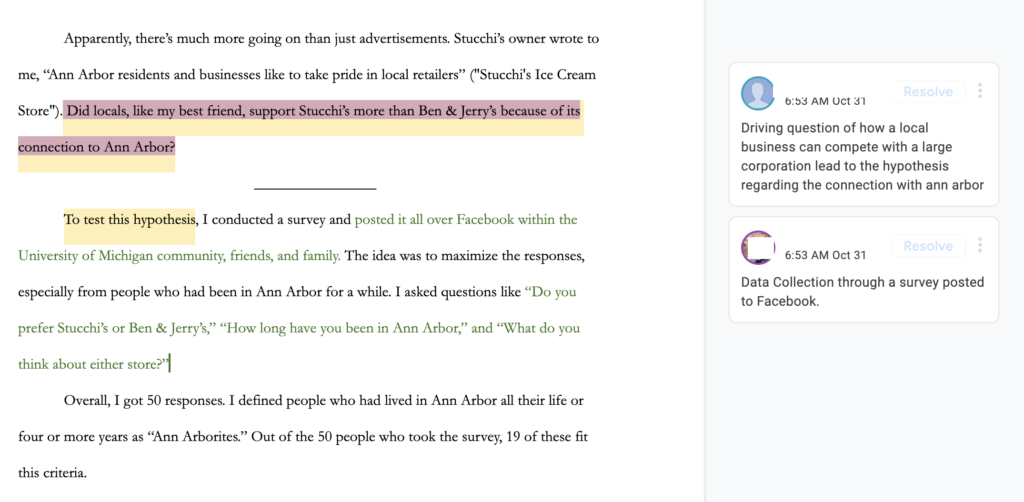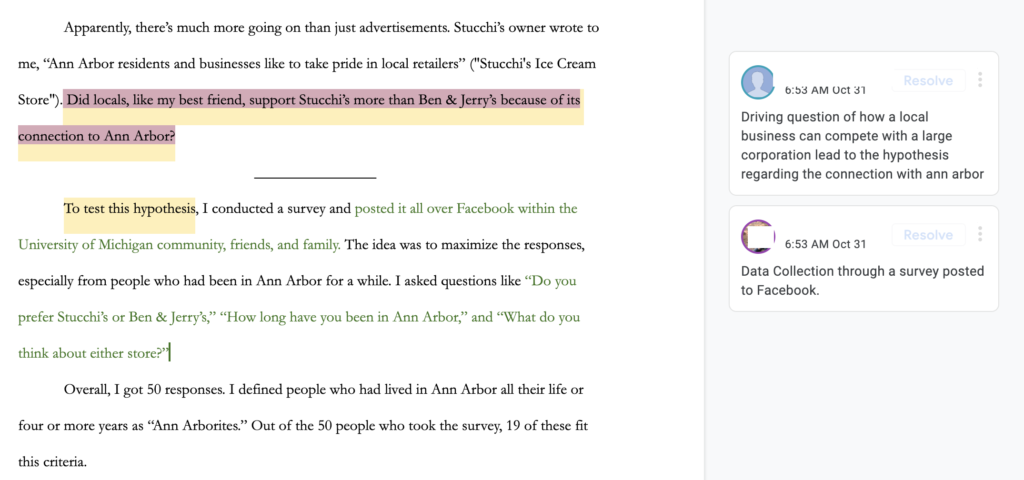Introduction
Digital platforms such as Google Docs offer spaces for students to visualize, conceptualize, and collaborate on learning. While teaching writing, I have observed that first-year students often struggle with academic writing skills including developing ideas, incorporating and citing sources, and organizing essays. In this article, I share a Google Docs activity I designed and implemented in a first-year writing class that asks students to color-code and annotate sample rhetorical analysis and research-based essays for elements such as citations, quotations, transition words, vocabulary, and structure. The assignment enhances students’ metacognitive awareness of the characteristics of essay writing in various genres and supports the social construction of learning. In addition, this activity fosters first-year writing learning goals including teaching students to develop strategies for composing and to “create complex, analytic, well-supported arguments that matter in academic contexts and beyond” (UM English 124/125 Learning Goals).
Color-Coding Rhetorical Analysis Essays
While teaching the rhetorical analysis genre, I encourage students to interpret rhetorical appeals such as logos, ethos, and pathos. I ask students to select an article of their choice that is targeted toward an audience within a particular discourse community that they are familiar with or interested in examining. As I state in the essay prompt (included below), I instruct students to “analyze and evaluate the effectiveness of the rhetorical strategies that the author employs in order to communicate his/her purpose. In addition, interpret the text in relation to the larger context.”
To scaffold the essay writing process, I share sample essays with the class and have students work in small groups to evaluate each essay based on the rubric criteria, which includes development/argument, structure/organization, and language/craft. In addition, as a way to facilitate students’ awareness of the language-level elements of essay writing, such as citations and transition words, I developed color-coding guidelines that ask students to color-code the following elements in each body paragraph of a sample essay and, optionally, in their own essay drafts. As a way to enhance accessibility for students with varying visual needs, I included options for identifying the elements using bold, italic, underline, and highlight:
- Citations to sources in red/bold
- Quotations from sources in green/italic
- Transition words/phrases in blue/underline
- Precise vocabulary/word choice in purple/highlight
In one class activity, students worked in small groups to color-code the sample essay “A Lopsided Pyramid: An Analysis on Michael Greger’s Call to Ditch the Dairy.” I shared the essay with the class as a Google Doc, and each student accessed the doc on their individual laptops, so that each member of the class could edit the doc simultaneously. I assigned each group to highlight a different body paragraph.

As illustrated in the screenshot, one group highlighted the name of the article’s author (Greger) in red, a quotation in green/italics (“accelerated aging, being overweight, canker sores, kidney stones, childhood asthma, constipation, prediabetes and diabetes, prostate and other cancers, heart disease, imbalanced hormones, mucus, Parkinson’s disease, rheumatoid arthritis, rising blood pressure, skin wrinkling, sudden infant death syndrome, ulcerative colitis, bacterial vaginosis, and Multiple Sclerosis”), transition words and phrases in blue/underline (“in addition,” “though the article is short,” and “also”), and precise vocabulary in purple (“methodically,” “shear,” “extremely,” “sophisticated,” “compromised,” and “bombarded”). Following the activity, I asked each group to share their observations about the paragraphs they highlighted.
Color-coding Research-based Essays

In addition to engaging students in this rhetorical analysis activity, I have adapted this color-coding exercise for research-based essays. In the research-based essay assignment, I ask students to examine a topic of their choice by conducting secondary well as primary research, including observations, surveys, or interviews. The assignment encourages students to contribute to a conversation that holds interest or significance to them. As students often investigate issues that arise from their personal interests, this genre can include traditionally narrative elements such as scene-setting and description as well as typical elements of research articles, including secondary sources, primary data collection, findings, analysis, and discussion. In this sense, this genre is hybrid in form, interweaving aspects of narrative, analytical, and research-based writing. Observing that students sometimes struggle with conceptualizing ways to structure their essays, especially when approaching unfamiliar genres such as this one, I developed an activity in which students highlight the sections of a sample essay entitled “A Tale of Two Ice Cream Stores.”
As shown in the instructions, each group is assigned to identify, highlight, and annotate a different section of the essay (exposition and context, driving questions/hypothesis, secondary source evidence, data collection and results, analysis and discussion, and conclusion).

As shown in the screenshot above, for example, a student highlighted the driving question in purple (“Did locals, like my best friend, support Stucchi’s more than Ben & Jerry’s because of its connection to Ann Arbor?”) and commented, “Driving question of how a local business can compete with a large corporation lead to the hypothesis regarding the connection with Ann Arbor.” Another group highlighted the description of the primary data collection in green, while a student commented, “Data Collection through a survey posted to Facebook.”

As shown in the second screenshot above, four students annotated the final paragraphs of the essay with their comments. As seen in the highlighted sections, the analysis (“what they stand for, and the quality of their products”) leads naturally into a conclusion (“But convenience comes with a price…”), while a further rhetorical question is posed within the conclusion (“Do we truly want everywhere to look the same? Have the same familiar stores, the same familiar logos?”). This screenshot illustrates the multilayered, intersecting nature of writing purposes and structures, showing that the sections are not necessarily linear, sequential, or mutually exclusive. Although this sample essay serves as one possible model or guide for approaching the assignment, I encourage students to structure their essays in flexible ways, according to their intended purposes for writing. For instance, I note the way the writer of the sample essay recursively generates new driving questions throughout the essay as opposed to only presenting initial questions in the opening.
Discussion
As illustrated, these color-coding activities render visible and legible the discrete elements of writing and enhance students’ metacognitive awareness of academic argumentation in various rhetorical situations. While collaborating on a Google Doc, students co-construct meaning by identifying key characteristics of written genres and by annotating the essays with their own commentary. Even so, one possible limitation of this approach might be that conceptions of writing are reduced to the surface-level features of a writing sample. In the future, I seek to encourage critical discussion of the shifting, evolving nature of academic writing as constructed by continual interactions across generic and discursive contexts, as writers shape and become shaped by the discourses they create. In this sense, students can become inspired not only to form their written compositions, but to transform their conceptions of writing as well.





'Visualizing Essay Elements: A Color-Coding Approach to Teaching First-year Writing' has 1 comment
August 30, 2020 @ 8:48 pm Erin
Great ideas on using color coding in comments and suggestions. I use random colors when I evaluate, but I can see the value of using specific colors for specific purposes. Thanks for the suggestions.